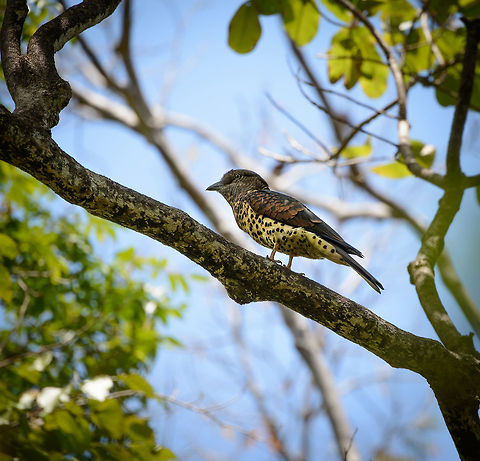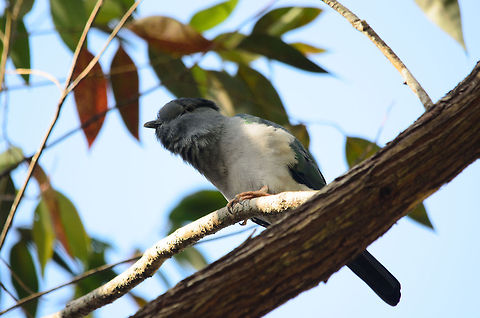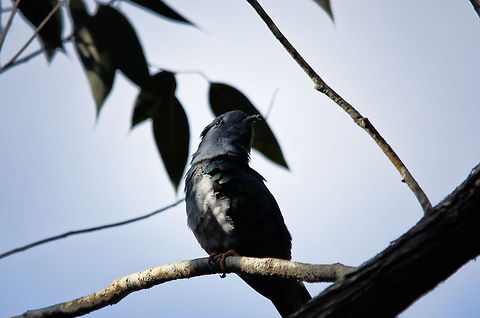
Appearance
The Cuckoo Roller has a total length of 40–50 cm , with nominate being largest, and ''L. d. gracilis'' smallest. Unlike the true rollers and ground rollers, where the sexes have identical appearance, the Cuckoo Roller is sexually dichromatic. Males have a mostly velvety grey chest and head, changing gradually to white on the remaining underparts . The back, tail, and wing-coverts are dark iridescent green with a purplish tinge , and the crown and eye-stripe are black. Females are mostly brown with strongly dark-spotted pale underparts . Juveniles are generally reported as resembling a dull female, but at least juveniles of ''L. d. gracilis'' are sexually dimorphic, and it is possible this also applies to the other subspecies. The bill is stout and the eyes set far back in the face. The legs and feet are small, and the feet have an unusual structure which has confused many ornithologists, but is now thought to be zygodactylous.
Distribution
The Cuckoo-roller occupies a wide variety of habitats, including altered areas. The habitat consist of forest, including rainforest, litoral forest, deciduos forest, spiny bush-forest and tree plantations. In the Comoros, the species is found on all the major islands, particularly in forested zones. The Cuckoo-roller can be found from near sea-level up to 2000 m.
Status
The species is not generally hunted and has proven resistant to habitat change that has threatened other native birds, and is considered least concern by the IUCN. The distribution of the Cuckoo-roller is vast and populations in Madagascar are able to persist in small forest fragments. Some areas with abundant populations include those broad expanses of forest in association with reserves such as Zahamena, Andringitra, Andohahela and Marojejy.Behavior
The diet of the Cuckoo Roller is not well known, but a 1931 expedition found that chameleons and insects, particularly locusts and caterpillars are important food items. Stomach have often been found lined with the hairs of caterpillars, and other prey taken include grasshoppers, cicadas, stick insects and geckos. The principal foraging technique is to perch motionless watching for prey, then to make a quick sally towards the prey when observed. They will also forage from the air. Prey is caught in the large bill and dispatched by beating it against a branch.Very few studies have investigated the breeding biology of the Cuckoo Roller. It has been described in the past as a polygamous breeder, but there is no evidence for this. The nest is located in tall trees, 4–6 m off the ground, in natural cavities. No lining is placed inside the cavity, the white eggs are laid directly on the bottom. The usual clutch size is around four eggs. Incubation is performed by the female only, with the male feeding her while she is in the nest. The incubation period is about 20 days, after which fluffy chicks are born. Chicks remain in the nest for 30 days before fledging.
Habitat
The Cuckoo-roller occupies a wide variety of habitats, including altered areas. The habitat consist of forest, including rainforest, litoral forest, deciduos forest, spiny bush-forest and tree plantations. In the Comoros, the species is found on all the major islands, particularly in forested zones. The Cuckoo-roller can be found from near sea-level up to 2000 m.The diet of the Cuckoo Roller is not well known, but a 1931 expedition found that chameleons and insects, particularly locusts and caterpillars are important food items. Stomach have often been found lined with the hairs of caterpillars, and other prey taken include grasshoppers, cicadas, stick insects and geckos. The principal foraging technique is to perch motionless watching for prey, then to make a quick sally towards the prey when observed. They will also forage from the air. Prey is caught in the large bill and dispatched by beating it against a branch.Very few studies have investigated the breeding biology of the Cuckoo Roller. It has been described in the past as a polygamous breeder, but there is no evidence for this. The nest is located in tall trees, 4–6 m off the ground, in natural cavities. No lining is placed inside the cavity, the white eggs are laid directly on the bottom. The usual clutch size is around four eggs. Incubation is performed by the female only, with the male feeding her while she is in the nest. The incubation period is about 20 days, after which fluffy chicks are born. Chicks remain in the nest for 30 days before fledging.
References:
Some text fragments are auto parsed from Wikipedia.